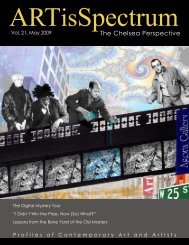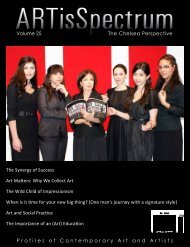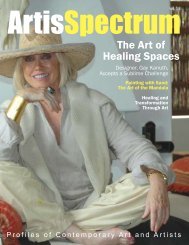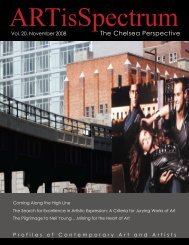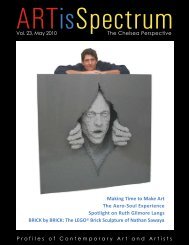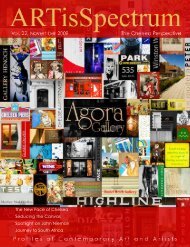CHELSEA ART: The New Thirty-Something Block ... - ARTisSpectrum
CHELSEA ART: The New Thirty-Something Block ... - ARTisSpectrum
CHELSEA ART: The New Thirty-Something Block ... - ARTisSpectrum
- No tags were found...
You also want an ePaper? Increase the reach of your titles
YUMPU automatically turns print PDFs into web optimized ePapers that Google loves.
Artistic Practices:Expecting the UnexpectedBy Donna L. Clovissingle bulb casts light in a darkenedA lecture hall of Tisch School of the Artsin <strong>New</strong> York City during the 2007 InternationalArt Symposium, an academic conferenceon global art practice. Upon closerexamination, the sculpture-like body liesstill across a table with hair sprawled andbloodied hands. Bent over and half nudefrom the waist down, it is a body in performance.One of the few artists appearing atacademic art conferences any more, DonnaClovis stands up after fifteen minutesof silent performance and lectures aboutthe importance of art in communities andspaces, such as conferences, where artistsare now forgotten.Gerald Pryor, artist and <strong>New</strong> York UniversityProfessor, uses his nude body as a measureof the outside world in a performancecalled, Mason Twine, A Body Measure,at the Grace Exhibition Space in Brooklyn,<strong>New</strong> York. <strong>The</strong> mason twine, a chordhistorically used for measuring objects,is connected to Pryor. <strong>The</strong> mason twineis cut and gathered to create drawings onthe wall, while live video feed is projectedduring and after the performance.“I did things that I didn’t know I woulddo,” said Pryor, “Bringing the surveyortape into the audience and wrapping themwas an unexpected part of the performance.”Winner of two NEA Awards, a <strong>New</strong> YorkFoundation grant, and a Gottlieb Foundationgrant, Pryor has performed, exhibited,curated and taught internationally for over30 years in countries like China, South Korea,Italy, England, and the United States.Artist Lyle Ashton Harris incorporatesinstallation, video, and photography in hiswork with himself as subject. His identitybasedphotographs of the 1990’s explorerace, gender, and sexuality through strategieslike masquerade, camp humor, andthe family snapshot. Of his recent work,Holland Cotter of the <strong>New</strong> York Timeswrote: “Like most really stimulating art,Mr. Harris’s eludes clean readings. It is34 ArtisSpectrumself-portraiture that is not quite self-portraiture,based on fiction that is not quitefiction.” His work has been included atthe Whitney Museum and will be part ofthe upcoming Venice Biennale in Italy in2007.This blurring of boundary, artistic practiceunexpected by the artist in the momentof performance, in unexpected spaces, inportraiture, not quite portraiture based onfiction not quite fiction, represents artisticpractices that challenge the norm.<strong>The</strong> TransdiasporaCurator Pritika Chowdhry of the Universityof Wisconsin, brings together twentytwoartists in an exhibition called, VisceralMappings: Transdiasporic Art Practices.Here, artist Megan Katz uses latex andcondom to cover fruits placed on a longtable. Artist Wendy Mirnov creates teethlinedporcelain bowls and artist HyunahKim makes ruptured skin porcelain bowlsset around as place settings. Artist AliceM. Unger places ceramics torsos clothedin silk corsets and seats them on highstools around the table at place settings.<strong>The</strong> exhibit conceptualizes a non-traditionalinstallation inspired by the curatorialstrategies of Fred Wilson, a creator of newexhibition contexts for the display of artand artifacts found in museum collectionsby non-traditional pairings and groupingsof objects. His installations lead viewersto recognize that changes in context createchanges in meaning.<strong>The</strong> term transdiaspora, created by Chowdhry,is divorced from essentialist notionsof race, gender, religion, or ethnicity, lendingitself to experimental re-interpretations.Transdiaspora includes artists thatclaim diasporic status based on migrationinto the United States as well as Americanartists who have traveled outside ofthe United States living in other countriesas part of the American diaspora abroad.Lesbian and gay populations may be diasporizeddue to social exile and ostracizationbased upon the writings of scholarssuch as Alan Sinfield, Gayatri Gopinathand Cindy Patton. Transdiasporic positionsalso include survivors of violencewho experience internal exile resulting inself-estrangement. It is currently arguedthat online communities are a highly cohesivebut a non-traditional diasporic formationas well.<strong>The</strong> exhibit has been selected by the NationalWomen’s Studies Association totravel from Wisconsin in April 2007 toChicago, Illinois for the annual conferencein June 2007.Nowadays, artists can be found anywhere,anytime, in real or virtual time and spacetransforming original perceptions of art.Artistic practices and communities arechanging quickly and globally, blurringold boundaries into new unexpected ideasand works reflecting the individuality andexperimentation of art by the artists.






